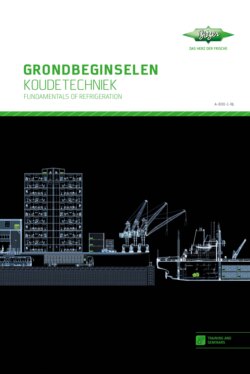Читать книгу GRONDBEGINSELEN KOUDETECHNIEK / In twee talen Nederlands/Engels - Volker Stamer - Страница 39
На сайте Литреса книга снята с продажи.
Оглавление3.2.2
Hoe ontstaat oververhitting?
Veel koelsystemen zijn uitgerust met thermostatische of
elektronisch geregelde expansieventielen. Hun functie
is om onder alle bedrijfsomstandigheden oververhit-
ting aan de uittrede van de verdamper te garanderen.
Dit betekent dat de verdamper slechts de hoeveel-
heid vloeibaar koudemiddel ontvangt die hij volledig
kan verdampen en (enigszins kan) oververhitten.
Hiervoor wordt gebruikgemaakt van een deel van het
verdamperoppervlak (ca. 10%) (zie Fig. 4).
Bij langere zuigleidingen door ruimten met een hogere
temperatuur ontstaat extra oververhitting door warmte-
opname uit de omgeving.
Door de zuigleiding te voorzien van een thermische
isolatie wordt overmatige oververhitting voorkomen.
Deze thermische isolatie voorkomt tevens de vorming
van condensaat of rijp op de leidingen.
Bij compressoren met ‚zuiggaskoeling‘ wordt het zuig gas
gebruikt om de motor te koelen. Het koudemiddel wordt
al oververhit voordat het in de compressieruimte belandt
(zie Fig. 5). De oververhitting van het zuiggas leidt ook tot
een hogere temperatuur van het persgas. Compressoren
met zuiggaskoeling zijn minder gevoelig voor werking
met onvoldoende oververhitting van het aanzuiggas.
Fig. 5 Oververhitting in een met zuiggas gekoelde compressor
Superheating in a suction-gas-cooled compressor [BITZER]
De vloeistof-zuiggas-warmtewisselaar (ook wel inter-
ne warmtewisselaar genoemd) wordt gebruikt voor de
warmteoverdracht tussen het vloeibare koudemiddel
in de vloeistofleiding en het gasvormige koudemiddel
in de zuigleiding (Fig. 6). Dit bewerkstelligt enerzijds
een onderkoeling van de vloeistof en anderzijds een
oververhitting van het zuiggas. Met een vloeistof-
3.2.2
How is superheating achieved?
Many refrigeration systems are equipped with thermo-
static or electronic expansion valves. Their task is to
ensure superheating at the evaporator outlet under all
operating conditions. This means that the evaporator
receives only the quantity of liquid refrigerant that can
evaporate completely in the evaporator and be slightly
superheated. Here, part of the evaporator surface
(approx. 10%) serves superheating (see Fig. 4 ).
If longer suction lines are routed through spaces with
higher temperatures, additional superheating occurs
due to heat absorption from the surroundings. Ex-
cessive superheating should be avoided by thermally
insulating the suction line. The thermal insulation also
prevents the formation of condensate or frost on the
pipes.
In compressors with ‘suction gas cooling’ the suction
gas is utilised to cool the motor. The refrigerant is ad-
ditionally superheated before it enters the compression
chamber (see Fig. 5). However, the greater suction
gas superheating also leads to a higher discharge
temperature. Compressors with suction gas cooling
are less sensitive to operation with insufficient suction
superheat.
The liquid suction line heat exchanger (also referred to
as the internal heat exchanger, or IHX for short) serves
to transfer heat between the liquid refrigerant in the
liquid line and the refrigerant vapour in the suction line
(Fig. 6). On the one hand, it causes subcooling of the
liquid and, on the other, superheating of the suction
gas. For many refrigerants, the refrigerating capacity
Koeltechnische specificaties // Refrigeration parameters
41
